Horns, Claws, and Teeth: The Animal Weapons Arms Race
16:53 minutes
Animals have developed horns, claws, and teeth to defend themselves, but what is the advantage of a bulky crab claw that weighs half as much as the entire animal, or 14-foot-wide antlers on the extinct Irish Elk that stood seven feet tall? Doug Emlen, a biologist and author of Animal Weapons, describes the evolutionary arms race that pushes these animal weapons to the extreme. (Read an excerpt from the book here.)
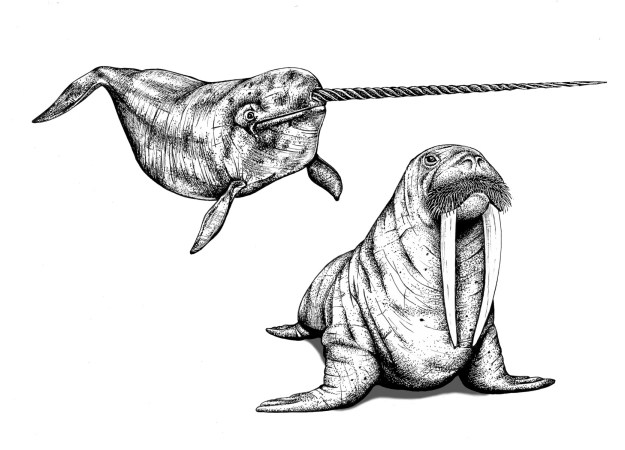
Narwhal and walrus. Illustration by David J. Tuss
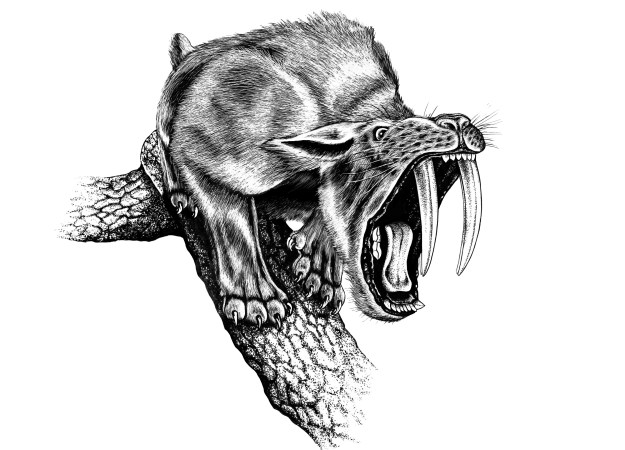
Saber-toothed cats probably leapt from trees onto unsuspecting mastodon calves. Illustration by David J. Tuss
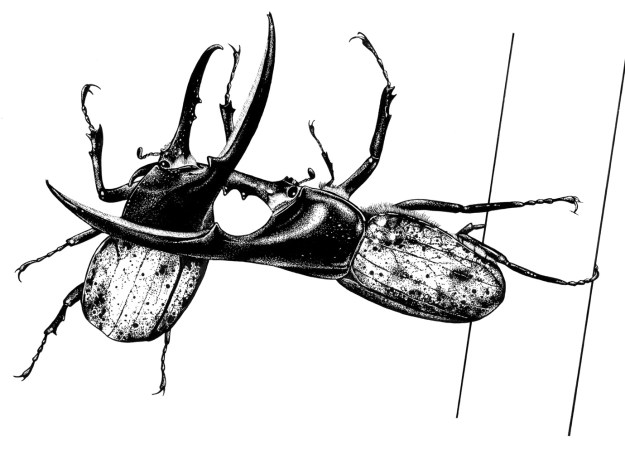
Battling rhinoceros beetles. Illustration by David J. Tuss
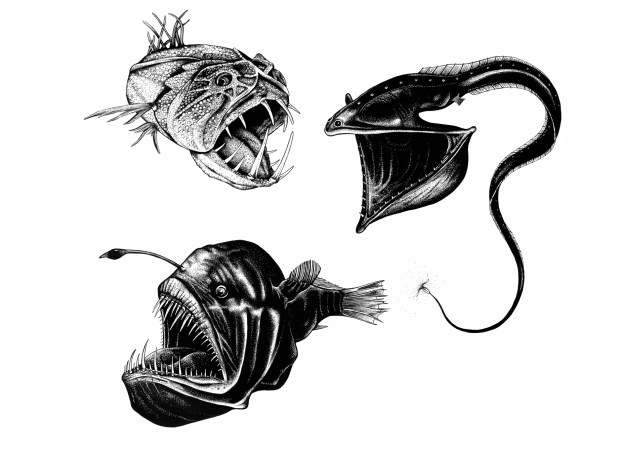
The fangtooth, umbrella eel, and anglerfish all have massive jaws and teeth. Illustration by David J. Tuss
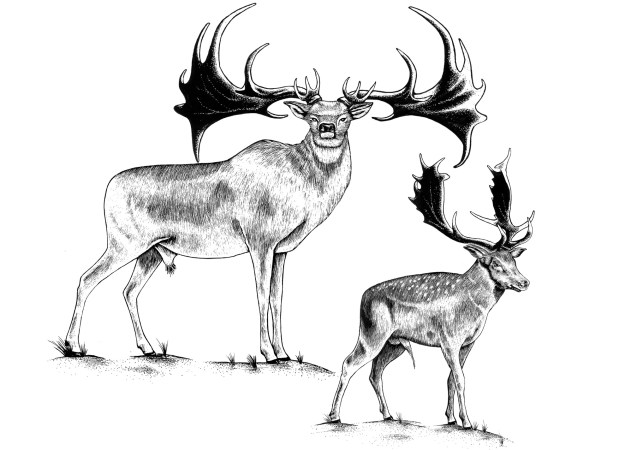
Irish elk had the largest antlers of any deer, shown here alongside a fallow deer buck. Illustration by David J. Tuss
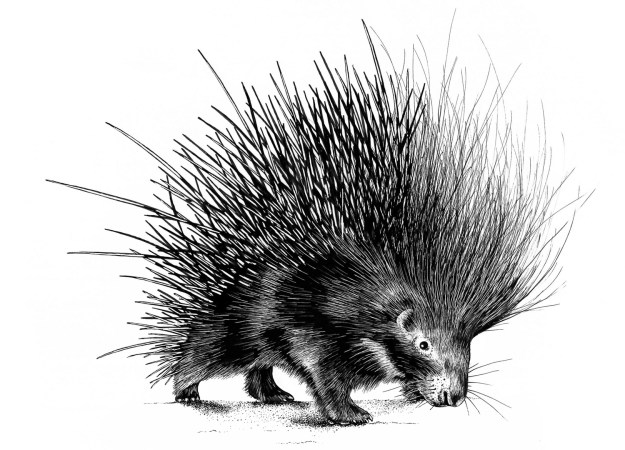
Porcupine spines are effective defensive weapons. Illustration by David J. Tuss
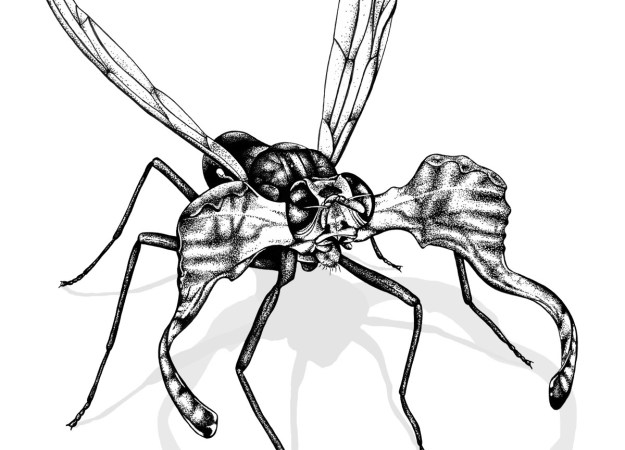
New Guinean moose fly with “antlers.” Illustration by David J. Tuss
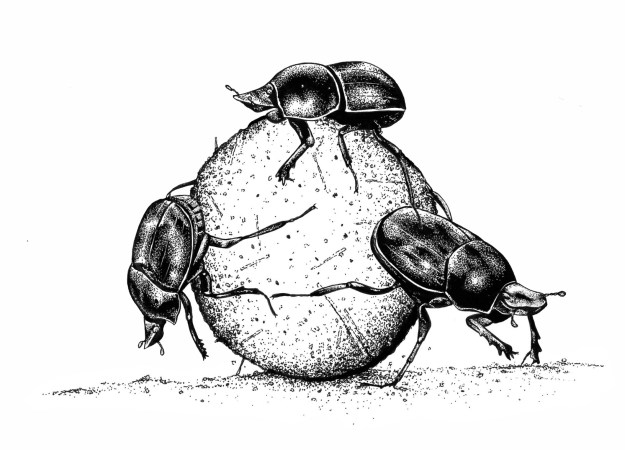
Ball-rolling dung beetles fight in scrambles, rather than duels. Illustration by David J. Tuss
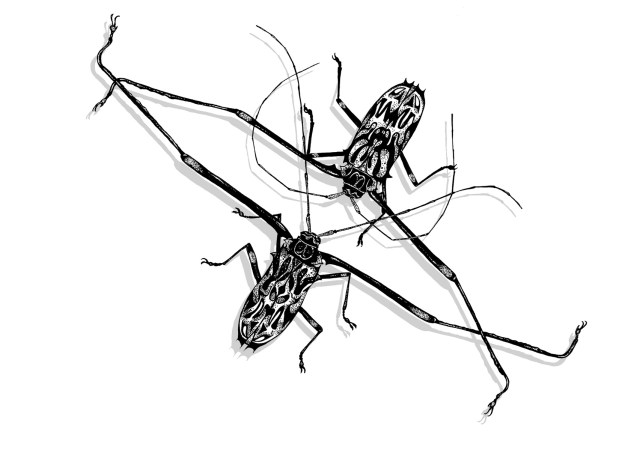
Fighting harlequin beetles. Illustration by David J. Tuss
Douglas J. Emlen is a professor of biology at the University of Montana and author of Animal Weapons: The Evolution of Battle (Holt, 2014).
Alexa Lim was a senior producer for Science Friday. Her favorite stories involve space, sound, and strange animal discoveries.
| Cookie | Duration | Description |
|---|---|---|
| _abck | 1 year | This cookie is used to detect and defend when a client attempt to replay a cookie.This cookie manages the interaction with online bots and takes the appropriate actions. |
| ASP.NET_SessionId | session | Issued by Microsoft's ASP.NET Application, this cookie stores session data during a user's website visit. |
| AWSALBCORS | 7 days | This cookie is managed by Amazon Web Services and is used for load balancing. |
| bm_sz | 4 hours | This cookie is set by the provider Akamai Bot Manager. This cookie is used to manage the interaction with the online bots. It also helps in fraud preventions |
| cookielawinfo-checkbox-advertisement | 1 year | Set by the GDPR Cookie Consent plugin, this cookie is used to record the user consent for the cookies in the "Advertisement" category . |
| cookielawinfo-checkbox-analytics | 11 months | This cookie is set by GDPR Cookie Consent plugin. The cookie is used to store the user consent for the cookies in the category "Analytics". |
| cookielawinfo-checkbox-functional | 11 months | The cookie is set by GDPR cookie consent to record the user consent for the cookies in the category "Functional". |
| cookielawinfo-checkbox-necessary | 11 months | This cookie is set by GDPR Cookie Consent plugin. The cookies is used to store the user consent for the cookies in the category "Necessary". |
| cookielawinfo-checkbox-others | 11 months | This cookie is set by GDPR Cookie Consent plugin. The cookie is used to store the user consent for the cookies in the category "Other. |
| cookielawinfo-checkbox-performance | 11 months | This cookie is set by GDPR Cookie Consent plugin. The cookie is used to store the user consent for the cookies in the category "Performance". |
| csrftoken | past | This cookie is associated with Django web development platform for python. Used to help protect the website against Cross-Site Request Forgery attacks |
| JSESSIONID | session | The JSESSIONID cookie is used by New Relic to store a session identifier so that New Relic can monitor session counts for an application. |
| nlbi_972453 | session | A load balancing cookie set to ensure requests by a client are sent to the same origin server. |
| PHPSESSID | session | This cookie is native to PHP applications. The cookie is used to store and identify a users' unique session ID for the purpose of managing user session on the website. The cookie is a session cookies and is deleted when all the browser windows are closed. |
| TiPMix | 1 hour | The TiPMix cookie is set by Azure to determine which web server the users must be directed to. |
| viewed_cookie_policy | 11 months | The cookie is set by the GDPR Cookie Consent plugin and is used to store whether or not user has consented to the use of cookies. It does not store any personal data. |
| visid_incap_972453 | 1 year | SiteLock sets this cookie to provide cloud-based website security services. |
| X-Mapping-fjhppofk | session | This cookie is used for load balancing purposes. The cookie does not store any personally identifiable data. |
| x-ms-routing-name | 1 hour | Azure sets this cookie for routing production traffic by specifying the production slot. |
| Cookie | Duration | Description |
|---|---|---|
| __cf_bm | 30 minutes | This cookie, set by Cloudflare, is used to support Cloudflare Bot Management. |
| bcookie | 2 years | LinkedIn sets this cookie from LinkedIn share buttons and ad tags to recognize browser ID. |
| bscookie | 2 years | LinkedIn sets this cookie to store performed actions on the website. |
| lang | session | LinkedIn sets this cookie to remember a user's language setting. |
| lidc | 1 day | LinkedIn sets the lidc cookie to facilitate data center selection. |
| S | 1 hour | Used by Yahoo to provide ads, content or analytics. |
| sp_landing | 1 day | The sp_landing is set by Spotify to implement audio content from Spotify on the website and also registers information on user interaction related to the audio content. |
| sp_t | 1 year | The sp_t cookie is set by Spotify to implement audio content from Spotify on the website and also registers information on user interaction related to the audio content. |
| UserMatchHistory | 1 month | LinkedIn sets this cookie for LinkedIn Ads ID syncing. |
| Cookie | Duration | Description |
|---|---|---|
| __jid | 30 minutes | Cookie used to remember the user's Disqus login credentials across websites that use Disqus. |
| _gat | 1 minute | This cookie is installed by Google Universal Analytics to restrain request rate and thus limit the collection of data on high traffic sites. |
| _gat_UA-28243511-22 | 1 minute | A variation of the _gat cookie set by Google Analytics and Google Tag Manager to allow website owners to track visitor behaviour and measure site performance. The pattern element in the name contains the unique identity number of the account or website it relates to. |
| AWSALB | 7 days | AWSALB is an application load balancer cookie set by Amazon Web Services to map the session to the target. |
| countryCode | session | This cookie is used for storing country code selected from country selector. |
| Cookie | Duration | Description |
|---|---|---|
| _fbp | 3 months | This cookie is set by Facebook to display advertisements when either on Facebook or on a digital platform powered by Facebook advertising, after visiting the website. |
| fr | 3 months | Facebook sets this cookie to show relevant advertisements to users by tracking user behaviour across the web, on sites that have Facebook pixel or Facebook social plugin. |
| IDE | 1 year 24 days | Google DoubleClick IDE cookies are used to store information about how the user uses the website to present them with relevant ads and according to the user profile. |
| NID | 6 months | NID cookie, set by Google, is used for advertising purposes; to limit the number of times the user sees an ad, to mute unwanted ads, and to measure the effectiveness of ads. |
| personalization_id | 2 years | Twitter sets this cookie to integrate and share features for social media and also store information about how the user uses the website, for tracking and targeting. |
| test_cookie | 15 minutes | The test_cookie is set by doubleclick.net and is used to determine if the user's browser supports cookies. |
| vglnk.Agent.p | 1 year | VigLink sets this cookie to track the user behaviour and also limit the ads displayed, in order to ensure relevant advertising. |
| vglnk.PartnerRfsh.p | 1 year | VigLink sets this cookie to show users relevant advertisements and also limit the number of adverts that are shown to them. |
| VISITOR_INFO1_LIVE | 5 months 27 days | A cookie set by YouTube to measure bandwidth that determines whether the user gets the new or old player interface. |
| YSC | session | YSC cookie is set by Youtube and is used to track the views of embedded videos on Youtube pages. |
| yt-remote-connected-devices | never | YouTube sets this cookie to store the video preferences of the user using embedded YouTube video. |
| yt-remote-device-id | never | YouTube sets this cookie to store the video preferences of the user using embedded YouTube video. |
| yt.innertube::nextId | never | This cookie, set by YouTube, registers a unique ID to store data on what videos from YouTube the user has seen. |
| yt.innertube::requests | never | This cookie, set by YouTube, registers a unique ID to store data on what videos from YouTube the user has seen. |
| Cookie | Duration | Description |
|---|---|---|
| _dc_gtm_UA-28243511-20 | 1 minute | No description |
| abtest-identifier | 1 year | No description |
| AnalyticsSyncHistory | 1 month | No description |
| ARRAffinityCU | session | No description available. |
| ccc | 1 month | No description |
| COMPASS | 1 hour | No description |
| cookies.js_dtest | session | No description |
| debug | never | No description available. |
| donation-identifier | 1 year | No description |
| f | never | No description available. |
| GFE_RTT | 5 minutes | No description available. |
| incap_ses_1185_2233503 | session | No description |
| incap_ses_1185_823975 | session | No description |
| incap_ses_1185_972453 | session | No description |
| incap_ses_1319_2233503 | session | No description |
| incap_ses_1319_823975 | session | No description |
| incap_ses_1319_972453 | session | No description |
| incap_ses_1364_2233503 | session | No description |
| incap_ses_1364_823975 | session | No description |
| incap_ses_1364_972453 | session | No description |
| incap_ses_1580_2233503 | session | No description |
| incap_ses_1580_823975 | session | No description |
| incap_ses_1580_972453 | session | No description |
| incap_ses_198_2233503 | session | No description |
| incap_ses_198_823975 | session | No description |
| incap_ses_198_972453 | session | No description |
| incap_ses_340_2233503 | session | No description |
| incap_ses_340_823975 | session | No description |
| incap_ses_340_972453 | session | No description |
| incap_ses_374_2233503 | session | No description |
| incap_ses_374_823975 | session | No description |
| incap_ses_374_972453 | session | No description |
| incap_ses_375_2233503 | session | No description |
| incap_ses_375_823975 | session | No description |
| incap_ses_375_972453 | session | No description |
| incap_ses_455_2233503 | session | No description |
| incap_ses_455_823975 | session | No description |
| incap_ses_455_972453 | session | No description |
| incap_ses_8076_2233503 | session | No description |
| incap_ses_8076_823975 | session | No description |
| incap_ses_8076_972453 | session | No description |
| incap_ses_867_2233503 | session | No description |
| incap_ses_867_823975 | session | No description |
| incap_ses_867_972453 | session | No description |
| incap_ses_9117_2233503 | session | No description |
| incap_ses_9117_823975 | session | No description |
| incap_ses_9117_972453 | session | No description |
| li_gc | 2 years | No description |
| loglevel | never | No description available. |
| msToken | 10 days | No description |